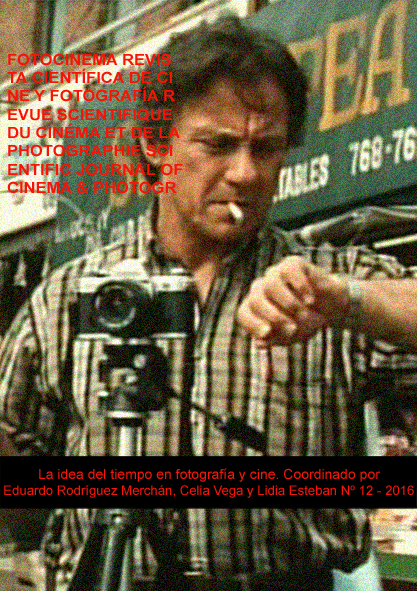La temporalidad longitudinal en el cine: de las Up series a Boyhood
DOI:
https://doi.org/10.24310/Fotocinema.2016.v0i12.6043Abstract
El presente artículo analiza la “temporalidad longitudinal” en el cine. Dicha temporalidad tiene una presencia significativa en el documental así llamado, “longitudinal”, que se lleva realizando desde los años sesenta hasta la actualidad. También se puede observar en las filmografías de corte autobiográfico, como las de Alan Berliner o Ross McElwee. Y recientemente el cine de ficción la ha trabajado de modo muy explícito en la exitosa Boyhood. Aquí se analizarán las pautas narrativas y temáticas que caracterizan este tipo de temporalidad, explorando los parecidos y diferencias entre las propuestas más clásicas de no-ficción y la reciente propuesta que plantea Boyhood desde el cine de ficción.Abstract:
This article analyzes the “longitudinal temporality” in cinema. This temporality has a significant presence in non-fiction cinema, in the so called “longitudinal documentary,” which has being made since the Sixties up to now. It can also be found in autobiographical filmographies such as the ones of Alan Berliner and Ross McElwee. And recently, fiction cinema has explored it in a very explicit way in the successful film Boyhood. Here we will analyze the narrative and thematic features that characterize this type of temporality, exploring the likeness and differences between the more classical proposals of non-fiction cinema and the recent one posed by Boyhood from the side of fiction cinema.
Palabras clave:Temporalidad; documental; longitudinal; autobiografía; Boyhood
Keywords:
Temporality; Documentary; Longitudinal; Autobiography; BoyhoodDownloads
Metrics
Downloads
Published
How to Cite
Issue
Section
License
All contents published in Fotocinema Revista científica de cine y fotografía are protected under the Creative Commons Attribution-NonCommercial-ShareAlike 4.0 International (CC BY-NC-SA 4.0) license. All about this license is available in the following link: <http://creativecommons.org/licenses/by-nc-sa/4.0>
Users can copy, use, redistribute, share and exhibit publicly as long as:
- The original source and authorship of the material are cited (Journal, Publisher and URL of the work).
- It is not used for comercial purposes.
- The existence of the license and its especifications are mentioned.
There are two sets of authors’ rights: moral and property rights. Moral rights are perpetual prerogatives, unrenounceable, not-transferable, unalienable, imprescriptible and inembargable. According to authors’ rights legislation, Fotocinema. Revista científica de cine y fotografía recognizes and respects authors moral rights, as well as the ownership of property rights, which will be transferred to University of Malaga in open access. The property rights are referred to the benefits that are gained by the use or the dissemination of works. Fotocinema. Revista científica de cine y fotografía is published in an open access form and it is exclusively licenced by any means for doing or authorising distribution, dissemination, reproduction, , adaptation, translation or arrangement of works.
Authors are responsable for obtaining the necessary permission to use copyrighted images.













13.png)




